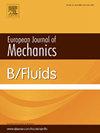探索湍流环境中灵活性对转子性能的影响
IF 2.5
3区 工程技术
Q2 MECHANICS
引用次数: 0
摘要
灵活性在现代转子的设计和性能中起着至关重要的作用。它对转子性能的影响及其适应外部流动干扰的能力已得到公认。在本研究中,我们采用数值模拟来探索浸没在湍流中的柔性转子的行为,旨在预测其柔性对性能指标的影响。转子的旋转运动和气流施加的力会导致叶片变形,包括弯曲和扭曲。这些变形不仅会破坏湍流尾流中的流动模式(涡),还会改变气动外形,从而影响推力、阻力和升力等基本性能。我们的目标是揭示雷诺数为 Re=O(104)、叶尖速比范围为 [0,18] 的湍流中叶片变形、旋转频率和转子性能之间的关系。我们证明了平均叶片弯曲角可以用修正的考奇数有效表示,并揭示了一个缩放规律。我们还研究了叶尖速度比的变化如何影响转子叶片的气动性能,要么放大,要么缩小。通过这项研究,我们加深了对转子柔韧性、变形和性能之间相互作用的理解,有助于优化转子设计和提高运行效率。本文章由计算机程序翻译,如有差异,请以英文原文为准。
Exploring the influence of flexibility on rotor performance in turbulent flow environments
Flexibility plays a crucial role in the design and performance of modern rotors. Its impact on rotor performance and its ability to adapt to external flow disturbances are well-established. In this study, we employ numerical simulations to explore the behavior of a flexible rotor submerged in a turbulent flow, aiming to forecast the influence of its flexibility on performance metrics. The rotational motion of the rotor and the forces imposed by the flow induce deformations in the blades, including bending and twisting. These deformations not only disrupt the flow patterns (vortices) in the turbulent wake but also modify the aerodynamic profiles, thereby affecting essential performance aspects such as thrust, drag, and lift. Our objective is to uncover the relationships between blade deformations, rotation frequencies, and rotor performance in a turbulent flow with a Reynolds number, , and for a tip speed ratio in the range . We demonstrate that the mean blade bending angle can be effectively expressed using a modified Cauchy number, revealing a scaling law. We also examined how the aerodynamic performance of the rotor blade is affected by variations in the tip speed ratio, either amplifying or reducing it. Through this research, we advance our understanding of the interplay between rotor flexibility, deformation, and performance, contributing to the optimization of rotor design and operational efficiency.
求助全文
通过发布文献求助,成功后即可免费获取论文全文。
去求助
来源期刊
CiteScore
5.90
自引率
3.80%
发文量
127
审稿时长
58 days
期刊介绍:
The European Journal of Mechanics - B/Fluids publishes papers in all fields of fluid mechanics. Although investigations in well-established areas are within the scope of the journal, recent developments and innovative ideas are particularly welcome. Theoretical, computational and experimental papers are equally welcome. Mathematical methods, be they deterministic or stochastic, analytical or numerical, will be accepted provided they serve to clarify some identifiable problems in fluid mechanics, and provided the significance of results is explained. Similarly, experimental papers must add physical insight in to the understanding of fluid mechanics.

 求助内容:
求助内容: 应助结果提醒方式:
应助结果提醒方式:


